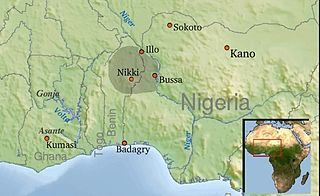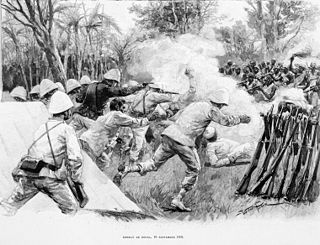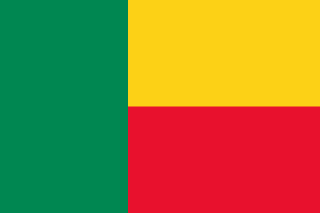 W
WThe underground town of Agongointo-Zoungoudo is located approximately 9 km from Abomey, in central Benin. The city was discovered in 1998 by the Danish company DANIDA. It consists of a series of bunkers and other housing structures around 10m deep underground, built in an apparent effort to provide dwelling as well as protection for warriors.
 W
WBanque d'Afrique Occidentale : was a bank French colonial authorities established in 1901 in Dakar, Sénégal, as the central bank of the colonies of French West Africa.
 W
WBorgu is a region in north-west Nigeria and in the northern Republic of Benin. It was partitioned between Great Britain and France by the Anglo-French Convention of 1898. People of Borgu were known as Bariba and Borgawa.
 W
WThis article lists the colonial governors of the former French Dahomey (1904–1958) in French West Africa, the present day nation of Benin.
 W
WThe Kingdom of Dahomey was an African kingdom that existed from about 1600 until 1904, when the last king, Béhanzin, was defeated by the French, and the country was annexed into the French colonial empire. Dahomey developed on the Abomey Plateau amongst the Fon people in the early 17th century and became a regional power in the 18th century by conquering key cities on the Atlantic coast.
 W
WThe Dutch Slave Coast refers to the trading posts of the Dutch West India Company on the Slave Coast, which lie in contemporary Ghana, Benin, Togo and Nigeria. The primary purpose of the trading post was to supply slaves for the plantation colonies in the Americas. Dutch involvement on the Slave Coast started with the establishment of a trading post in Offra in 1660. Later, trade shifted to Ouidah, where the English and French also had a trading post. Political unrest caused the Dutch to abandon their trading post at Ouidah in 1725, now moving to Jaquim, at which place they built Fort Zeelandia. By 1760, the Dutch had abandoned their last trading post in the region.
 W
WThis apparent flag of the Kingdom of Benin is an unidentified West African flag which was discovered in the territory of the former Kingdom of Benin. The flag is believed to have been brought to the United Kingdom by Admiral F. W. Kennedy following the 1897 Benin expedition. The original flag is currently held by the National Maritime Museum in Greenwich near London. It is not known if the flag has a proper name. It is commonly referred to as the Flag of the Benin Empire or the Flag of the Kingdom of Benin as it was recovered from territory under the Benin Empire's control, though remains unknown whether the flag had any official usage or connection to the Empire's central government. Another theory is the flag being created by the Itsekiri people as a battle flag and it getting adopted by the Edo as the Itsekiri were a core ally to Benin.
 W
WThe First Franco-Dahomean War, which raged in 1890, was a conflict between France, led by General Alfred-Amédée Dodds, and Dahomey under King Béhanzin. The French emerged triumphant after winning the Battle of Abomey.
 W
WThe Second Franco-Dahomean War, which raged from 1892 to 1894, was a major conflict between the French Third Republic, led by General Alfred-Amédée Dodds, and the Kingdom of Dahomey under King Béhanzin. The French emerged triumphant and incorporated Dahomey into their growing colonial territory of French West Africa.
 W
WFrench Dahomey was a French colony and part of French West Africa from 1894 to 1958. After World War II, by the establishment of the French Fourth Republic in 1947, Dahomey became part of the French Union with an increased autonomy. On 11 December 1958, the French Fifth Republic was established and the French Union became the French Community. The colony became the self-governing Republic of Dahomey within the Community, and two years later on 1 August 1960, it gained full independence.
 W
WFrench West Africa was a federation of eight French colonial territories in Africa: Mauritania, Senegal, French Sudan, French Guinea, Ivory Coast, Upper Volta, Dahomey and Niger. The federation existed from 1895 until 1958. Its capital was Saint-Louis, Senegal until 1902, and then Dakar until the federation's collapse in 1960.
 W
WHaffon (1695–1727) was the last ruler of the Kingdom of Whydah before it was captured by the forces of Dahomey in 1727.
 W
WJews of the Bilad al-Sudan describes West African Jewish communities which were connected to known Jewish communities which were expelled from the Middle East, North Africa, or Spain and Portugal and emigrated to West Africa. Various historical records state that at one time, they were present in the Ghana, Mali, and Songhai empires, which was then called the Bilad as-Sudan a name which is derived from the Arabic term which means Land of the Blacks. In later years Jews who were expelled from Spain, Portugal, and Morocco and emigrated to West Africa, also formed their own communities off the coast of Senegal as well as on the Islands of Cape Verde. These Jewish communities continued to exist for hundreds of years but they eventually disappeared as a result of changing social conditions, persecution, migration, and assimilation.
 W
WThe Kingdom of Dahomey was an African kingdom that existed from about 1600 until 1904, when the last king, Béhanzin, was defeated by the French, and the country was annexed into the French colonial empire. Dahomey developed on the Abomey Plateau amongst the Fon people in the early 17th century and became a regional power in the 18th century by conquering key cities on the Atlantic coast.
 W
WThis is a list of European colonial administrators responsible for the territory of French West Africa, an area equivalent to modern-day Mauritania, Mali, Niger, Senegal, Guinea, Ivory Coast, Burkina Faso, Benin and Togo.
 W
WThe People's Republic of Benin was a socialist state located in the Gulf of Guinea on the African continent, which would become present-day Benin. The People's Republic was established on 30 November 1975, after the 1972 coup d'état in the Republic of Dahomey. It effectively lasted until 1 March 1990, with the adoption of a new constitution, and the abolition of Marxism-Leninism in the nation in 1989.
 W
WThis is a survey of the postage stamps and postal history of Benin, formerly Dahomey.
 W
WThe Republic of Dahomey was established on December 11, 1958, as a self-governing colony within the French Community. Prior to attaining autonomy it had been French Dahomey, part of the French Union. On August 1, 1960, it attained full independence from France.
 W
WSahel-Benin Union was a short-lived union of four former French colonies of French West Africa, that were the four Republics of Upper Volta, Niger, Dahomey (Benin) and Côte d’Ivoire.
 W
WIn World War II, French West Africa was not a major scene of major fighting. Only one large-scale action took place there: the Battle of Dakar. The region remained under the control of Vichy France after the fall of France and until the Allied invasion of North Africa. French Gabon, the only colony of French Equatorial Africa not to join Free France after the armistice, fell to invading Free French Forces from the neighbouring colonies after the Battle of Gabon, further isolating West Africa.
 W
WZinkpo, also called the Throne of Dahomey, was a royal throne from Dahomey, present-day Benin. It was one of the main objects on display in the Nacional Museum of Brazil, in Rio de Janeiro. The object also received the names zingpogandeme and zinkpojandeme. It is estimated to have been produced at the turn of the eighteenth and nineteenth centuries. It was exposed in a central showcase in the Kumbukumbu Room, of which was the main highlight.